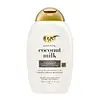What's inside
What's inside
 Key Ingredients
Key Ingredients

No key ingredients
 Benefits
Benefits

 Concerns
Concerns

 Ingredients Side-by-side
Ingredients Side-by-side

Water
Skin ConditioningSodium Methyl Cocoyl Taurate
CleansingDecyl Glucoside
CleansingCocamidopropyl Betaine
CleansingCocos Nucifera Fruit Extract
EmollientHydrolyzed Milk Protein
Skin ConditioningSodium Hydrolyzed Potato Starch Dodecenylsuccinate
Coco-Glucoside
CleansingAmodimethicone
Guar Hydroxypropyltrimonium Chloride
Skin ConditioningHydrogenated Castor Oil
EmollientGlycol Distearate
EmollientPEG-150 Distearate
EmulsifyingHexylene Glycol
EmulsifyingCitric Acid
BufferingSodium Hydroxide
BufferingSodium Benzoate
MaskingParfum
MaskingWater, Sodium Methyl Cocoyl Taurate, Decyl Glucoside, Cocamidopropyl Betaine, Cocos Nucifera Fruit Extract, Hydrolyzed Milk Protein, Sodium Hydrolyzed Potato Starch Dodecenylsuccinate, Coco-Glucoside, Amodimethicone, Guar Hydroxypropyltrimonium Chloride, Hydrogenated Castor Oil, Glycol Distearate, PEG-150 Distearate, Hexylene Glycol, Citric Acid, Sodium Hydroxide, Sodium Benzoate, Parfum
Water
Skin ConditioningGlycerin
HumectantCetearyl Alcohol
EmollientHelianthus Annuus Seed Oil
EmollientCarica Papaya Fruit Extract
Skin ConditioningCocos Nucifera Oil
MaskingStearamidopropyl Dimethylamine
EmulsifyingGlyceryl Stearate
EmollientHydroxypropyl Guar
Emulsion StabilisingCaprylyl Glycol
EmollientTartaric Acid
BufferingCetyl Esters
EmollientPotassium Sorbate
PreservativeSalicylic Acid
MaskingLinalool
PerfumingParfum
Masking
 Reviews
Reviews

Ingredients Explained
These ingredients are found in both products.
Ingredients higher up in an ingredient list are typically present in a larger amount.
Parfum is a catch-all term for an ingredient or more that is used to give a scent to products.
Also called "fragrance", this ingredient can be a blend of hundreds of chemicals or plant oils. This means every product with "fragrance" or "parfum" in the ingredients list is a different mixture.
For instance, Habanolide is a proprietary trade name for a specific aroma chemical. When used as a fragrance ingredient in cosmetics, most aroma chemicals fall under the broad labeling category of “FRAGRANCE” or “PARFUM” according to EU and US regulations.
The term 'parfum' or 'fragrance' is not regulated in many countries. In many cases, it is up to the brand to define this term.
For instance, many brands choose to label themselves as "fragrance-free" because they are not using synthetic fragrances. However, their products may still contain ingredients such as essential oils that are considered a fragrance by INCI standards.
One example is Calendula flower extract. Calendula is an essential oil that still imparts a scent or 'fragrance'.
Depending on the blend, the ingredients in the mixture can cause allergies and sensitivities on the skin. Some ingredients that are known EU allergens include linalool and citronellol.
Parfum can also be used to mask or cover an unpleasant scent.
The bottom line is: not all fragrances/parfum/ingredients are created equally. If you are worried about fragrances, we recommend taking a closer look at an ingredient. And of course, we always recommend speaking with a professional.
Learn more about ParfumWater. It's the most common cosmetic ingredient of all. You'll usually see it at the top of ingredient lists, meaning that it makes up the largest part of the product.
So why is it so popular? Water most often acts as a solvent - this means that it helps dissolve other ingredients into the formulation.
You'll also recognize water as that liquid we all need to stay alive. If you see this, drink a glass of water. Stay hydrated!
Learn more about Water